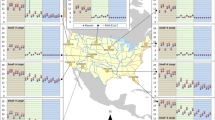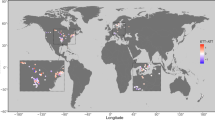Abstract
A deterministic, validated, one-dimensional, unsteady-state lake water quality model was linked to a daily weather data base to simulate daily water temperature profiles in lakes over a period of twenty-five (1955–79) years. Twenty seven classes of lakes which are characteristic for the north-central U.S. were investigated. Output from a global climate model (GISS) was used to modify the weather data base to account for a doubling of atmospheric CO2. The simulations predict that, after climate change, epilimnetic temperatures will be higher but increase less than air temperature, hypolimnetic temperatures in seasonally stratified dimictic lakes will be largely unchanged or even lower than at present, evaporative water loss will be increased by as much as 300 mm for the season, onset of stratification will occur earlier and overturn later in the season, and overall lake stability will become greater in spring and summer.
Similar content being viewed by others
References
Baker, D. G., Kuehnast, E. L., and Zandlo, J. A.: 1985, ‘Climate of Minnesota, Part 15 - Normal Temperatures (1951–1980) and Their Application’, Agricultural Experimental Station University of Minnesota, AD-SB-2777.
Blumberg, A. F. and Di Toro, D. M.: 1990, ‘Effects of Climate Warming on Dissolved Oxygen Concentrations in Lake Erie’,Transact. Amer. Fisher. Soc. 119(2, 210–223.
Carlson, R. E.: 1977, ‘A Trophic State Index for Lakes’,Limnol. Oceanogr. 22, 361–369.
Coutant, C. C.: 1990, ‘Temperature-Oxygen Habitat for Freshwater and Coastal Striped Bass in a Changing Climate’,Transact. Amer. Fish. Soc. 119(2, 240–253.
Croley II, T. E.: 1990, ‘Laurentian Great Lakes Double-CO2 Climate Change Hydrological Impacts’,Clim. Change 17, 27–47.
ERLD/MNDNR: 1990, ‘Minnesota Department of Natural Resources Fisheries Division Lake Data Base’, expanded by U.S. Environmental Protection Agency Environmental Research Laboratory Duluth.
Ford, D. E. and Stefan, H. G.: 1980, ‘Thermal Predictions Using Integral Energy Model’,Jour. Hydraul. Divis. ASCE 106, HY1, 39–55.
Gorham, E. and Boyce, F. M.: 1989, ‘Influence of Lake Surface Area and Depth upon Thermal Stratification and the Depth of the Summer Thermocline’,J. Great Lakes Res. 15, 233–245.
Gu, R. and Stefan, H. G.: 1990, ‘Year-Round Temperature Simulation of Cold Climate Lakes’,Cold Regions Sci. Technol. 18, 1–14.
Heiskary, S. A., Wilson, C. B., and Larsen, D. P.: 1987, ‘Analysis of Regional Patterns in Lake Water Quality: Using Ecoregions for Lake Management in Minnesota’,Lake Reserv. Manag. 3, 337–344.
Heiskary, S. A. and Wilson, C. B.: 1988, ‘Minnesota Lake Water Quality Assessment Report’, Minnesota Pollution Control Agency, St. Paul, p. 49.
Henderson-Sellers, B.: 1988, ‘Sensitivity of Thermal Stratification Models to Changing Boundary Conditions’,Appl. Mathemat. Modell. 12, 31–43.
Hengeveld, H. G.: 1990, ‘Global Climate Change: Implications for Air Temperature and Water Supply in Canada’,Transact. Amer. Fisher. Soc. 119(2, 176–182.
Hondzo, M. and Stefan, H. G.: 1991, ‘Three Case Studies of Lake Temperature and Stratification Response to Warmer Climate’,Water Resourc. Res. 27(8, 1837–1846.
Hondzo, M. and Stefan, H. G.: 1992a, ‘Propagation of Uncertainty due to Variable Meteorological Forcing in Lake Temperature Models’,Water Resourc Res. 28(10, 2629–2638.
Hondzo, M. and Stefan, H. G.: 1992b, ‘Water Temperature Characteristics of Lakes Subjected to Climate Change’, University of Minnesota, St. Anthony Falls Hydraulic Laboratory, Project Report No. 329, p. 185, August.
Hutcinson, G. E.: 1957, ‘A Treatise on Limnology’, Vol. I, John Wiley & Sons, Inc., p. 1015.
Imberger, J. and Patterson, J. C.: 1989, ‘Physical Limnology’, in Hutchinson, J. W. and Wu, T. Y. (eds.),Advances in Applied Mechanics, Academic Press, Vol.27, 303–475.
Jones, P. D., Wigley, T. M. L., and Wright, P. B.: 1986, ‘Global Temperature Variations between 1861 and 1984’,Nature 332(31, 430–434.
Kerr, R. A.: 1989, ‘1988 Ties for Warmest Year’,Science 243(17, 891–892.
Magnuson, J. J., Meisner, J. D., and Hill, D. K.: 1990, ‘Potential Changes in Thermal Habitat of Great Lakes Fish After Global Climate Warming’,Transact. Amer. Fisher. Soc. 119(2, 254–264.
McCormick, M. J.: 1990, ‘Potential Changes in Thermal Structure and Cycle of Lake Michigan Due to Global Warming’,Transact. Amer. Fisher. Soc. 119(2, 183–194.
Meisner, J. D., Goddier, J. L., Regier, H. A., Shuter, B. J., and Christie, W. J.: 1987, ‘An Assessment of the Effects of Climate Warming on Great Lakes Basin Fishes’,J. Great Lakes Res. 13(3, 340–352.
National Center for Atmospheric Research: 1990, Data Support Section, Personal communication Roy Jenne and Dennis Joseph, Boulder, Colorado.
Omernick, J. M.: 1987, ‘Ecoregions of the Conterminous United States’, Annals of the Assoc. of Amer. Geogr. Vol.77(1, 118–125.
Riley, M. J. and Stefan, H. G.: 1988, ‘MINLAKE: A Dynamic Lake Water Quality Simulation Model’,Ecolog. Modell. 43, Elsevier Science Publ., Amsterdam, 155–182.
Robertson, D. M.: 1989, ‘The Use of Lake Water Temperature and Ice Cover as Climatic Indicators’, Ph.D. thesis, University of Wisconsin-Madison, p. 330.
Robinson, P. J. and Finkelstein, P. L.: 1990, ‘Strategies for the Development of Climate Scenarios for Impact Assessment: Phase I Final Report’, USEPA, Atmospheric Research and Exposure Assessment Laboratory, EPA/600/53-90/026.
Schertzer, W. M. and Sawchuk, A. M.: 1990, ‘Thermal Structure of the Lower Great Lakes in a Warm Year: Implications for the Occurrence of Hypolimnion Anoxia’,Transact. Amer. Fisher. Soc. 119(2, 195–209.
Schindler, D. W., Beaty, K. G., Fee, E. J., Cruikshank, D. R., DeBruyn, E. R., Findley, D. L., Londsey, G. A., Sherer, J. A., Stainton, M., and Turner, M. A.: 1990, ‘Effects of Climatic Warming on Lakes of the Central Boreal Forest’,Science 250, 16 November, 967–970.
Stefan, H. G.: 1989, ‘Lake Mixing Dynamics and Water Quality Models’,J. Minnes. Acad. Sci. 55, No. 1.
Stefan, H. G. and Ford, D. E.: 1975, ‘Temperature Dynamics in Dimictic Lakes’,J. Hydraul. Divis. ASCE 101, No. HY1, 97–114.
Stefan, H. G., Hanson, M. J., Ford, D. E., and Dhamotharan, S.: 1980, ‘Stratification and Water Quality Predictions in Shallow Lakes and Reservoirs’, Proc. Second Int'l Symp. on Stratified Flows, International Association for Hydraulic Research, 1033–1043.
Author information
Authors and Affiliations
Rights and permissions
About this article
Cite this article
Hondzo, M., Stefan, H.G. Regional water temperature characteristics of lakes subjected to climate change. Climatic Change 24, 187–211 (1993). https://doi.org/10.1007/BF01091829
Received:
Revised:
Issue Date:
DOI: https://doi.org/10.1007/BF01091829




